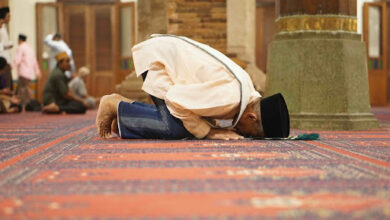
DDHK.ORG - The law of facing the Qibla is obligatory when performing the fardhu prayer because it is a legal requirement for prayer based on verse 144 of Surah Al-Baqarah. However, the meaning of the Qibla itself differs according to the position of the person praying whether he sees the Ka'bah, or does not see the Ka'bah, but sees the mosque, or does not see the mosque at all because of the position that is far from the Ka'bah.
Review:
Narrated from Imam Malik, he said;
أن الكعبة قبلة أهل المسجد, والمسجد قبلة أهل مكة, ومكة قبلة أهل الحرم, والحرم قبلة أهل الدنيا
"The building of the Ka'bah is the qibla of the congregation in the mosque, the mosque is the qibla of the inhabitants of Makkah, Makkah is the qibla of the inhabitants of al-Haram (hijaz), while al-Haram is the qibla of the population of the world. (Bâ'alawî, Bughyah al-Mustarsyidin, (Beirut: Dar al-Kutub al-Ilmiyyah, cet. 5, 2016), p. 53)
Ibn Rushd said;
أَمَّا إِذَا أَبْصَرَ الْبَيْتَ فَالْفَرْضُ عِنْدَهُمْ هُوَ التَّوَجُّهُ إِلَى عَيْنِ الْبَيْتِ وَلَا خِلَافٌ ِا خذَلَافٌ ِا. أَمَّا إِذَا غَابَتِ الْكَعْبَةَ عَنِ الْأَبْصَارِ فَاخْتَلَفُوا مِنْ ذَالِكَ فِي مَوْضِعَيْنِ: أَحَدُهُمْعُا وَالثَّانِي هَلْ فَرْضُهُ الْإِصَابَةَ أَوِ الْاجْتِهَادَ: أَعْنِي إِصَابَةُ الْجِهَةِ أَوِ الْعَيْنِ أَعْنِي إِصَابَةُ الْجِهَةِ أَوِ الْعَيْنِ أَعْنِِ فَذَهَبَ قَوْمٌ إِلَى أَنَّ الْفَرْضَ هُوَ الْعَيْنُ وَذَهَبَ آخَرُوْنَ إِلَى أَنَّهُ الْجِهَةَ.
"If someone can see the Ka'bah, then there is no difference of opinion that it is obligatory for him to face the building. Meanwhile, if he cannot see the Ka'bah, the scholars have different opinions on the following two matters; (1) What is required to face the building of the Ka'bah or towards the Ka'bah? (2) Does it have to be precise regarding the direction or building of the Ka'bah or is there enough effort to direct it? A group of ulama insists that they face the building directly, while others face it". [Ibn Rushd, Bidayah al-Mujtahid, (Cairo: Dar al-Hadis, cet. 1, 2004), vol.1, p.118.)
The meaning of building is the Ka'bah; the black stone in the shape of a cube which was pointed to by the Prophet as the Qibla when he was in the Haram mosque as narrated by Ibn 'Abbas;
لما دخل النبي صلى الله عليه وسلم البيت دعا في نواحيه كلها ولم يصل حتى خرج منه فلما خرج ركع ركعتين في قبل الكعبة, وقال هذه القبلة
"When the Prophet sallallaahu 'alaihi wa sallam entered the Ka'bah, he prayed facing all directions and he did not pray until he finally came out. Outside the Ka'bah he established two rak'ah prayers facing the Ka'bah. Then he said; This is the Qibla". [HR. Al-Bukhari, no.383.]
This history explains that if someone is in the Haram mosque and sees the Ka'bah, then the Qibla is the building of the Ka'bah because of the position of the Prophet. sallallaahu 'alaihi wa sallam when hinting that it is in the Haram mosque and see the Ka'bah. Whereas people who cannot see the Ka'bah, so many scholars say that it is enough to face the Qibla, meaning that if people who are far away are not facing the building of the Ka'bah, their prayers are still valid.
Ibn Rushd continued;
واتفاق المسلمين على الصف الطويل خارج الكعبة يدل على أن الفرض ليس هو العين أعني إذا لم تكن الكعبة مبصرة. والذي أقوله إنه لو كان واجبا قصد العين لكان حرجا وقد قال تعالى: {وما جعل عليكم في الدين من حرج} فإن إصابة العين شيء لا يدرك إلا بتقريب وتسامح بطريق الهندسة واستعمال الأرصاد في ذلك فكيف بغير ذلك من طرق الإجتهاد ونحن لم نكلف الإجتهاد فيه بطريق الْهَنْدَسَةِ الْمَبْنِيِّ عَلَى الْأَرْصَادِ الْمُسْتَنْبِطِ مِنْهَا طُوْلَ الْبِلَادِ وَعَرْضَهَا.
"The straight rows of Muslims that extend outside the Ka'bah show that what is required is not facing the building of the Ka'bah, that is, if the Ka'bah is not visible. Because I think that if they have to face the building of the Ka'bah, it will certainly be difficult, even though Allah Ta'âlâ has said; "We don't make trouble for you in religion". Moreover, that facing right into the building of the Ka'bah is difficult to describe except in a close position or using meteorological science and science. Then what about just doing pure ijtihad, even though we are not burdened with doing ijtihad using technology that can be used to determine the length and width of an area?". [Ibn Rushd, Bidayah al-Mujtahid, vol.1, p.119.]
Related to the question above, if someone is in an emergency situation as described in a narrow room, both equilateral and rectangular, it is necessary to see if the room is rectangular, while the one that leads to the Qibla is the width that does not fit for bow or prostration. , then a person can tilt slightly to the right or to the left in order to make more room for him to bow and prostrate, because tilting a little does not make a person out of the direction of the Qibla. It is based on meaning Syahr in paragraph;
فَوَلِّ وَجْهَكَ شَطْرَ الْمَسْجِدِ الْحَرَامِ ۚ وَحَيْثُ مَا كُنْتُمْ فَوَلُّوا وُجُوهَكُمْ شَطْرَهُ ۗ
"Turn your face towards the Grand Mosque. Every where you are, turn your face on him". [Surah Al-Baqarah, verse 144]
Imam al-Bahuti said;
ََ ِضَََََِ ََِّْ
"People who are far from the Ka'bah are required to face the direction of the Ka'bah, so it is okay to tilt slightly to the right or to the left in a normal way.". [Al-Bahuti, al-Rawdh al-Murabba ', (Beirut: Dar al-Fikr, nd), p. 64.)
What is meant by direction is the direction of the wind where the Qibla is located. For residents of the eastern hemisphere of Mecca, the qibla is to the west. And for residents of the northern hemisphere of Mecca, the qibla is to the south, and so on. As when the Prophet sallallaahu 'alaihi wa sallam while in Medina and facing Mecca to the south, he said;
ا الْمَشْرِقِ الْمَغْرِبِ لَةٌ
"The direction that stretches between east and west is the Qibla".
In the narrative also Ibn Umar said while in Medina;
إِذَا جَعَلَتِ الْمَغْرِبُ عَنْ يَمِيْنِكَ وَالْمَشْرِقُ عَنْ يَسَارِكَ فَمَا بَيْنَهُمَا قِبْلَلةٌ قتبْلَلةٌ
"If you face the Qibla, west on your right, east on your left, then what stretches between the two is the Qibla.". [HR. Al-Tirmidhi, no.344.]
In another narration, Usman Ibn 'Affan also said that when he was in Medina;
كَيْفَ يُخْطِئُ الرَّجُلُ الصَّلَاةَ وَمَا بَيْنَ الْمَشْرِقِ وَالْمَغْرِبِ قِبْلَقةٌ مَا لَمْ يَتَحَرَ العَّم
"How could a person be wrong in the direction of his prayer when the direction between east and west is the Qibla, as long as he accidentally faces east (left direction when the position is in Medina)". [Ibn Abdil Barr, Al-Tamhid, (Cairo: Muassasah Quthubah, tt), vol.17, p.59.)
All these narrations explain that a slight tilt to the right or to the left as long as it is not totally facing to the right and to the left does not invalidate prayer, and the prayer is still valid. Therefore, if a person is in a rectangular room whose broad side is pointing towards the Qibla, then he or she can turn a little to the right or to the left so as to get space for bowing and prostration, because that direction is still called the Qibla.
In conclusion, there are two options for the above problems:
- Keep facing the Qibla when takbiratul ihram and standing position, and tilt slightly when bowing and prostration.
- Being practiced with a sick person or traveling, so it is permissible to sit down but face the Qibla.
Allah knows best.
…
Source: Minority Fiqh [DDHK News]



